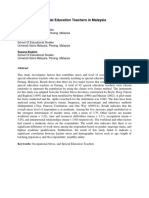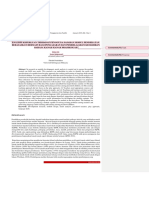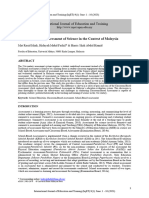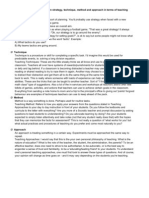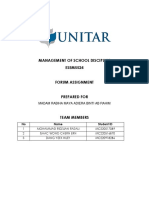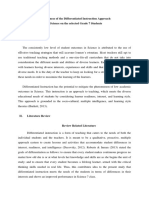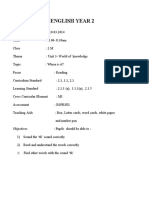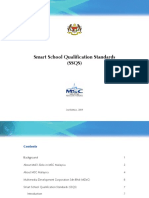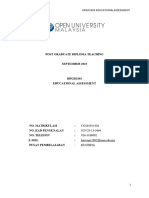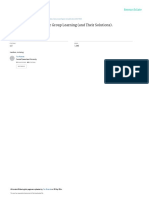Group Vs Individual Assignment
Group Vs Individual Assignment
Uploaded by
Yvonne TiongCopyright:
Available Formats
Group Vs Individual Assignment
Group Vs Individual Assignment
Uploaded by
Yvonne TiongOriginal Title
Copyright
Available Formats
Share this document
Did you find this document useful?
Is this content inappropriate?
Copyright:
Available Formats
Group Vs Individual Assignment
Group Vs Individual Assignment
Uploaded by
Yvonne TiongCopyright:
Available Formats
Journal of Information Technology Education
Volume 2, 2003
How Fair are Group Assignments? A Survey of Students and Faculty and a Modest Proposal
Marilyn Ford Griffith University, Nathan, Australia
M.Ford@griffith.edu.au
Jenny Morice University of Portsmouth, Portsmouth, England
Jenny.Morice@port.ac.uk
Executive Summary
Group assignments are becoming increasingly popular in education. While some academics would admit that they lessen their workload, many would say group assignments give students the real world group experience needed for later employment. Problems with group assignments have been noted in the literature, but the extent to which staff are aware of problems is not clear, nor is it clear whether students think group assignments could be valuable. The present study set out to obtain staff and student views on the problems with, and the worth of, group assignments and, given the comments, to consider a better strategy for implementing group work. A questionnaire was administered to 69 students and 12 academicians in an IT school at a university. It was found that while nearly half the students reported frequently having problems with group assignments, only 2 of the 12 staff members reported frequently encountering problems. Reasons for the discrepancy are considered. The perceived benefits and negative aspects of group assignments were also considered. The students seem to put more store on sharing ideas and social interaction than staff and they are concerned about timetabling and logistical problems, which staff are unaware of. Students and staff are both concerned about the inequality of contribution by the different group members. Students do see potential value in group work; even for those who had frequently encountered problems, only just over half said they preferred individual assignments. It was found that many students believe they should have group assignments because they will be working in groups in the IT and Multimedia industries. Given that students see the potential value of group assignments, but often encounter problems, this paper offers a new strategy that aims to maintain the good features of group assignments while removing the negative. We suggest that many problems with group assignments can be overcome by making group assignments more closely replicate conditions in industry. We propose a three-phase strategy using management techniques on a small scale: (1) the initiation phase where an academic staff member, who acts as a group manager, advertises positions on projects, students apply for the positions, and appointments are made; (2) the management phase where the group manager and each group meet according to an agreed schedule and where group Material published as part of this journal, either on-line or in members work according to contracts; and (3) the print, is copyrighted by the publisher of the Journal of Informacompletion phase where a post-mortem and intion Technology Education. Permission to make digital or paper copy of part or all of these works for personal or classroom use is dividual marking (not group marking) take place.
granted without fee provided that the copies are not made or distributed for profit or commercial advantage AND that copies 1) bear this notice in full and 2) give the full citation on the first page. It is permissible to abstract these works so long as credit is given. To copy in all other cases or to republish or to post on a server or to redistribute to lists requires specific permission and payment of a fee. Contact Editor@JITE.org to request redistribution permission.
Keywords: group assignments, inequities in marking, industry-like group experience
The original version of this paper was published as one of the 24 best papers in the proceedings of the 2003 Informing Science and IT Education Conference in Pori, Finland http://2003.insite.nu
How Fair are Group Assignments?
Introduction
With less money to fund higher education and with increased student numbers, many academics are turning to group assignments to lessen their workload (Morris & Hayes, 1997; Thong, 1995). Many argue that group assignments have educational benefits (Baskin, 2001; Candy, Crebert, & OLeary, 1994) and they may well have. However, some studies indicate that there are problems with group assignments (Michalchik, et al., 2001; Morris & Hayes, 1997; Parsons & Drew, 1996). The benefits of group assignments are said to include: higher order thinking (Cohen, 1994); better communication and conflict management (Johnson & Johnson, 1996); greater understanding (Fall, Webb, & Chudowski, 2000); and the development of skills transferable to the work environment such as teamwork, time ma nagement, and interpersonal skills (Candy, et al., 1994). Problems identified with group assignments include: freeriders leaving all or most of the work to others (Brokaw & Rudd, 2002; Morris & Hayes, 1997); clashes between group members (Brokaw & Rudd, 2002; Chang, 1999; Morris & Hayes, 1997); and time management and organisational problems (Morris & Hayes, 1997). While studies have identified problems, it is not clear to what extent staff who give group assignments are aware of the problems. Due to increased workloads it could be that staff are, in fact, not well informed about problems. Further, while problems have been identified in the literature, it is not clear to what extent students, in particular Information Technology students, believe that group assignments could be valuable. If, indeed, it is found that students believe there could be value in group work despite problems they have experienced, then new strategies for group assignments need to be developed which take into account the experiences of staff and students.
Background
The present study investigated staff and student perceptions to group assignments in a Computing and Information Technology School. Even though no formal School policy particularly encourages the use of group assignments, it is a commonly adopted assessment strategy within the School. However, there are often significant differences between subjects in the amount of group versus individual assignments used; for example, in a final year project subject, group assignments account for 100% of the assessable items, while a one semester web development subject was generally assessed as 60% group work and 40% individual assignments. In addition, due to the popularity within the School of the use of group assignments it is often the case that a student will be involved in between one and four groups (each comprising between two and six members) per semester depending on the amount of credit points being studied by each individual. For
Web development course Group 1 5 members Individual Student User Interface Design course Group 3 5 members
Digital video course Group 2 5 members Elective/ Option
Figure 1. Example group me mbership map
368
Ford & Morice
example, a student studying multimedia and undertaking all designated core subjects in one semester at second year level would be in a group for each of the following semester long subjects: web development; digital video; and user interface design. The elective/option choice may or may not involve a group assignment. Such a situation is illustrated in Figure 1. While some groups will contain common members, timetabling and logistical problems often preclude the formation of common groups across subjects. This means that full time students could be coordinating meetings and group activities with 10 to 16 other individuals. Historically, subject conveners, students, and parents have noticed difficulties with group assignments. The organisation of administrative roles within the school is such that students experiencing problems and issues in any subject within the degree(s) would generally report the problems, in the first instance, to the Program Director. The authors had each been fulfilling the role of Program Director for the programmes investigated and were aware of a range of issues in group assignments across a reasonably large student cohort. Problems seemingly centre on issues such as inequality in marking and group conflict. In one programme, problems within group assignments had become moderately serious, with two specific instances requiring the intervention of the Head of School to resolve the issues. While it is not necessarily uncommon for issues within group assignments to reach a stage where outside intervention is needed to resolve tension, these two specific instances were particularly worrisome for the students and staff involved. In addition, on a personal (pastoral) level, we were aware that the problems faced by many students in group assignments were adding to the stress felt by students. For students already struggling with the pressures of university life in general, the added burden of trying to work within a seemingly dysfunctional team was often the last straw. As a result, the following questions arise: Why use group assignments in subjects? Do students prefer group or individual assignments? Do students encounter problems more often than staff realize? What strategies need to be implemented to resolve and manage problems within group assignments?
Our research focussed on examining attitudes toward, and rationale for, the use of group assignments. In particular, we focused on whether group assignments were considered by staff and students to be a valid, equitable, and reliable part of an overall assessment strategy. Given the results of our study, a strategy for future group work is suggested.
Method
A questionnaire was administered at the end of two final year classes in the School of Computing and Information Technology at Griffith University. All students, 69 in total, completed the questionnaire. A similar questionnaire was given to 12 staff members. The questionnaires were anonymous.
Results
Perceiving Problems
It was found that only 2 of the 12 staff (16.7%) reported that they had frequently encountered problems when they had used group assignments. Both of these staff members said they did not use group assignments anymore. Another staff member who said he had sometimes encountered problems also
369
How Fair are Group Assignments?
said he no longer used them. All other staff members still used group assignments; of these, 3 said they encountered problems rarely and 6 said they encountered them sometimes. No staff member reported never having problems with group assignments. The results for the students were startlingly different. There were 68 students who responded to the question concerning the extent to which they had experienced problems with group assignments. Like staff members, no student reported never having problems. However, 32 of the 68 students (47%) said they had frequently encountered problems. The difference in responding frequently compared with responding rarely or sometimes was statistically significantly different for the students and staff, with Fishers Exact Probability 1-tailed test, p = .046. It appears, then, that the staff are not aware of the extent of the problems students face. Of the remaining 36 students, 24 said they encountered problems sometimes, and 12 said they rarely had problems.
Making Problems Apparent to Staff
The difference between the frequency with which students have problems and the frequency with which staff notice problems is not surprising given the students responses to the question of how they dealt with problems. Of the 64 students who responded, only 5 (7.8%) said they told the lecturer, while the other 59 kept the problem within the group or to themselves, either discussing the problem with other members, doing the work themselves, ignoring the problems, or withdrawing material from the nonworking team members. There are some clues to why the students usually keep the problems away from the lecturer. Of the 5 students who said they had approached the lecturer, 2 said that it did no good anyway, while one said it did help. One student who had not gone to the lecturer said, It is not easy to deal with the problems as it tends to hurt [the] other [person] . Of course, there are other ways staff could notice problems, and they did occasionally, but this was rare. One staff member had observed a problem in a class, while another had noticed the problem in a groups documentation. All other ways in which staff noticed problems came from students telling the staff member, by either just reporting the problem or through an interview or weekly consultation. In the staff comments there are clues to why students might sometimes feel that telling staff is pointless. One staff member, who no longer uses group assignments, said he ignored problems and let the exam marks differentiate between students. Two others indicated that, on discovering problems, they would act as a facilitator to the groups potential solving of the problem. The impression was that it was a problem for the group to solve.
Preferences for Group or Individual Work
It could be expected that for students reporting different frequencies of problems with group assignments, their preference for individual versus group assignments would differ. This seems to be the case. Of the 31 students who reported frequent problems and who responded to the question about preferences, 17 (54.8%) said they preferred individual assignments, while the others said they preferred group assignments or said it did not matter. In contrast, of the 9 students who said they rarely had encountered problems and who responded to the question, only 2 (22.2%) said they preferred individual assignments. Of the 22 students who said they had sometimes encountered problems and who responded to the question about preferences, 11 (50%) preferred individual assignments. These differences are not significantly different. However, there is a trend for those rarely encountering problems to have less of a preference for individual work than the other students.
370
Ford & Morice
The Most Valuable Aspects of Group Work
Students
Students were asked what they saw as the most valuable aspects of group assignments. Table 1 gives the six most valuable aspects according to students. 1. Learning from others and sharing ideas 2. Learning to work in a group, which reflects real industry 3. The social interaction 4. The division of work, which saves time 5. The fact that you can achieve more a larger project and better quality 6. Gaining communication skills Table 1: The six most valuable aspects of group assignments identified by students. The rankings were similar regardless of how often students had encountered problems. However, none of the 12 students who had rarely encountered problems identified points 5 or 6. Table 2 gives the six most negative aspects according to students. 1. The inequality in the contribution of members 2. Timetable and other logistical problems 3. Conflicts 4. The fact that marking does not reflect differences in contributions 5. The fact the some members lack required skills 6. Being dependent on other people Table 2: The six most negative aspects of group assignments identified by students. Regardless of how often students had encountered problems, point 1 was given as the most negative aspect. For those who had rarely encountered problems, conflict was the second most identified problem, while for those who had sometimes or frequently encountered problems, timetabling and logistics ranked second. Point 4 was not identified by the students who had rarely encountered problems. Given that the students who said they rarely had problems differ somewhat in their rankings and their preferences for group work from the other two groups, it is important to look at other ways the groups differ. Interestingly, there is evidence that a students academic record may have some influence on how often they encounter problems. Of those encountering problems rarely, 55% normally get a passing grade, and 45% an honours grade. For the students encountering problems sometimes, 9% normally get a passing grade and 91% an honours grade. For those frequently encountering problems, 36% normally get a passing grade and 64% an honours grade. The results for the sometimes groups were significantly different from the other two groups. The fact that the results for the frequently group are midway between those of the other two groups suggests there are probably complex factors at play. Lets focus on the rarely group. It may be that several students in the rarely group, are relatively weak and it may be these students who benefit from being in a group and who are not worried about the fact that marking does not reflect differences in contributions. There are also quite a number of weak students in the frequently group. While good students may frequently encounter problems in groups, some poor students also seem to often encounter problems. One of the poorer students who reported
371
How Fair are Group Assignments?
frequent problems said that the group constantly pressures [the] black sheep until he/she does (sic) a positive contribution. The poorer students may be happy to be in a group that can help and so rarely encounter problems, but they may sometimes be in a group where they are pressured to give more, and in this case may frequently encounter problems.
Staff
Staff were also asked what they saw as the most valuable and negative aspects of group assignments. They identified points 2 and 5 of Table 1 as the most valuable aspects. The third most valuable aspect for staff was the fact that group assignments require less marking and lecture preparation. Regarding the negative aspects, the three most prominent for staff were points 1, 3, and 4 of Table 2. No staff member identified point 2 as a problem.
The Perceived Fairness of Marking
Finally, lets consider the extent to which students felt that group marking schemes fairly dealt with individual differences in effort and ability. Of the 41 students who gave a definite response to the question, 10 (24.4%) said it was fair, 23 (56.1%) said it was not fair, and 8 (19.5%) had mixed reactions. It is interesting that this particular question was responded to less than other questions. Some students remarked that they did not have sufficient information to answer the question, with one student, for example, stating we dont know, we have no feedback to that extent.
Discussion
A Lack of Information Flow
It can be seen that both students and staff see that there are major problems with group assignments, though they also see there could be benefits. It can also be seen that there is a lack of information flow between staff and students. The staff are generally not aware that so many students frequently encounter problems. Also, while they identify some of the same problems as students, they do not identify the second greatest problem for students the timetabling and logistical problems in organising a group. It seems, too, that a number of students do not feel well enough informed about the extent to which group marking schemes deal with individual effort and ability.
Individual versus Group?
It is interesting that even with the students who had encountered problems frequently, approximately 45% still did not give a preference for individual assignments. These students obviously feel there is value in group assignments. It is thus very worthwhile to consider how the running of group assignments could be improved. To determine what new strategies could be used for group assignments, the perceived valuable and negative aspects of group assignments need to be considered more. It is apparent from the results given in Table 1 that many students enjoy interacting with others in groups and they value the experience because they know they will probably need to work in teams as Information Technology specialists. Some of the problems they encounter may be found in varying degrees when they work in teams in industry:
372
perhaps there will be an inequality in contribution, though probably not to the extreme of having someone do no work at all conflicts will probably arise
Ford & Morice
some team members may lack required skills they will still be somewhat dependent on other people
The other two problems identified by students may not be such big problems when working in teams in industry: Timetabling and other logistical problems are less likely to occur as the industry team would have more compatible timetables than the students do: often students have very different class timetables for their different subjects and often students, apart from studying, have part-time jobs. Marking will not be a factor in industry. There may be financial rewards or other incentives for good work and negative personal consequences for bad work. However, the work supervisor is likely to have a closer relationship to the team members than staff generally have with students. The data from the present study suggest, in fact, that the information flow between staff and students is quite low.
The results of this study suggest that a micro management strategy may be appropriate for student group assignments. There exists a need to establish a closely managed environment whereby student teams would work in a situation that more closely mimics real-world work teams: as one student remarked about group projects, they try to be like the real world but theyre really not. However, it needs to also be remembered that the third most valuable aspect of group assignments for staff was the fact that they require less marking and lecture preparation. What is needed, then, is a strategy that more closely resembles industry but that is not too burdensome for staff.
A New Strategy for Group Assignments
As discussed, students frequently see value in taking part in group assignments but are often frustrated because instead of simply facing the normal problems that can be encountered in team work in industry, they must face other problems or the same problems in an extreme form. Any new group assignment management strategy would need to address the following: Improving information flow between staff and students Ensuring reasonable equality in contribution levels Reducing logistical problems for both staff and students Providing conflict resolution procedures Providing an environment for learning team work skills Ensuring equality in marking
The new strategy was developed from two separate administrative frameworks already successfully used in subjects taught within the school. In one programme, students are required to undertake an industry internship. Internship places were advertised and students nominated for places on the basis of best fit according to the skills required by the client. Although every student was given a place, competition for specific highly prized places was keenly felt by students. Students were required to submit a mini CV, highlighting their skills and experience and to write to short key selection criteria. The internship had been managed for three years through an online learning environment that included a weekly reporting facility for students. Industry partners were provided with access to a password protected section in order to access internship information docume nts, submit weekly attendance reports and a final report and student mark. The system worked effectively with a low level of technical maintenance required. The implementation of the online site meant that administrative requirements (associated with course management and requirements tracking) were effectively managed online.
373
How Fair are Group Assignments?
While aspects of the management processes used in the internship subject were used in the development of the new strategy, it is not suggested that the new strategy can only be implemented using computing technology. As is demonstrated in tables 3 through 5 below, the new strategy is sufficiently flexible to be implemented either on paper or on the screen. The choice of implementation is largely a matter of personal administrative preference of the lecturer(s) involved. In the second subject, group assignments had been managed through a weekly reporting process and a scalable marking framework. Student teams were required to report to the lecturer each week to discuss progress and any other issues arising. The marking scheme for the subject was structured to allow for increases or decreases in individual student marks, depending on peer evaluations. The new strategy incorporated these successful elements. Three important features of our micro ma nagement strategy are: first, an academic staff member acts in a role equivalent to a workplace group manager; second, an environment is provided for weekly meetings with the group manager and the group; and third, work contracts are signed. From these three features, there are other emergent features that should alleviate the problems that need to be addressed. The suggested micro management strategy is designed to run alongside the usual project ma nagement processes implemented by each group. It is also recommended that some initial time be spent on discussing team work processes including conflict resolution and possible problems, the amount of time depending on how much work the class has already done on such topics. There are three phases in the strategy. 1. An initiation phase where the group manager advertises positions on projects, students apply to the positions, and appointments are made. 2. A management phase throughout which the group manager and the group meet according to an agreed schedule and during which the group members agree to work according to agreed-upon contracts. 3. A completion phase where a post mortem and marking take place. Managerial roles are assigned as follows: Management board: which consists of academic staff members who each supervise a project group Group Manager who is an academic staff member assigned to a project group Project Manager who is a student group member
The aim of the initiation phase is to divide the class into effective groups that will work together well and that consist of members who are somewhat comparable in terms of effort they are likely to put in and where students are treated equally regardless of the position in the social structure of the class. To this end students would respond to job advertisements. In their application they would need to say why they want the position and how they are qualified for it. They would also need to provide information on times when they cannot work on the project. To ensure fairness, they could use their student ID and be asked not to give their current Grade Point Average. The idea is that people are put into groups according to how much effort and ability went into constructing the application and on having a compatible timetable with other members. Having members who seem to be offering the same amount of effort and who do not have timetable clashes should go a long way towards overcoming problems. The
374
Ford & Morice DESCRIPTION This phase occurs at the commencement of the subject and comprises: - subject organisational activities - team application and selection processes - team formation - first team meeting STAFF ACTIVITIES At the completion of this phase staff will have: - informed students of process and procedure - created simulated job advertisements for each project and project position - posted job advertisements to inform students of offerings - short listed candidates for specific jobs (with the management board) - assigned all applicants to a suitable project - Informed all applicants of outcome - assigned staff member group manager to each team - ensured all team members have a copy of the team member contact sheet STUDENT ACTIVITIES At the completion of this phase all students will have: - selected and responded to a maximum of two job advertisements - submitted a CV for the advertised positions - been assigned to one project team on the basis of CV and timetable - contacted all team members listed on the team member contact sheet
Table 3. The initiation phase strategy would also help students develop resume writing skills. Table 3 sets out some of the processes involved in the initiation phase. While the work involved in the initiation phase might seem onerous, much of it needs to be done regardless of how a subject is run. The job advertisements, for example, would include information normally given on an assignment sheet. Some marks could be awarded on the basis of the CVs. The major aim of the management phase is to create a good information flow between staff and group members. It should ensure that the staff member is very well informed of who is doing what. It should also give the students clear guidelines of what is expected of them as valuable group members. To this end, students would be expected to agree on and sign work contracts and set out a schedule of meetings and to keep time sheets. It should also provide a forum for students to admit the existence of conflicts
DESCRIPTION This phase commences at the completion of the initiation phase and continues until all project deliverables are completed. This phase comprises: - individual work contracts - group work schedules - individual weekly timesheets STAFF ACTIVITIES During this phase the group manager will: - negotiate, approve and implement individual work contracts with each group member - approve all proposed group meeting and work schedules - attend each weekly group meeting with the group manager - collect and sign off all individual weekly timesheets - maintain a written weekly attendance, participation and contribution register - dismiss members not complying with their contract STUDENT ACTIVITIES During this phase students will: - negotiate and implement individual work contracts - in collaboration with group members develop group meeting and work schedules - attend each scheduled meeting - complete and submit a weekly timesheet
Table 4. The management phase
375
How Fair are Group Assignments?
and attempt to reach a resolution. Where a student does not keep to a contract the Group Manager should dismiss the student, replicating what would happen in industry in this context the student could be required to do a project by his or herself and be penalised 10%. This would help alleviate the problem that some students noted that unlike in real industry the noncontributors cannot be sacked. Table 4 sets out some of the processes involved in the management phase. The management phase need not be burdensome on staff. The weekly meetings with the Group Manager, the group manager, could be held during scheduled class time. For example, the last half hour of a class could be devoted to group meetings where the group manager goes from group to group, discussing problems, collecting sheets and attendance records. The aim of the completion phase is to give feedback to students on their performance and to give students time to analyse what they have learnt about working in a team. Given that the staff member has been in good contact with the group members throughout, marks should be able to be awarded fairly on the basis of participation, contribution, and contract expectations. There would be an individual mark for each individual, not a group mark. Table 5 sets out some of the processes involved in the completion phase.
DESCRIPTION This phase commences at the completion of the Management phase. This phase comprises: - marking - project post mortem STAFF ACTIVITIES During this phase the group manager will: - assign each group member a mark for contract, participation and contribution - give each group member feedback on overall performance STUDENT ACTIVITIES During this phase students will: - attend a project post mortem - attend a feedback session with the group manager
Table 5. The completion phase The completion phase should be no more burdensome on staff than any other grading. In fact, it should be easier given the knowledge the staff member has gained of the group members throughout the running of the subject. It is worth noting that the use of a micro management strategy could be perceived by both staff and students as unnecessarily prescriptive and intrusive. However, the results of our study suggest that in order to solve the main problems arising from group assignments, and to adequately replicate industry within the (typically) less structured university environment, groups need to be closely monitored by staff. It will be the case that not all projects are of suitable size and scope to gain benefit from using the suggested management strategy. For example, where the class enrolment is small (perhaps under 15) and where students are asked to work in very small groups comprising only pairs, the use of the suggested micro management strategy will be unnecessarily prescriptive and will add an unnecessary administrative burden.
Conclusion
It is all too apparent that many students, often very good students, suffer needlessly when doing group assignments. While some academics might claim that it is good to let students face problems arising from group work, it is pointless having them face problems that they will not see in the workplace. Simply making students do assignments together is not preparing them for team work in industry. It is not
376
Ford & Morice
simulating real life in industry. It stresses many students and gives them grades they do not deserve either inflated or deflated. It appears that staff use group assignments for a number of reasons. Some staff hold the belief that group assignments replicate or at least partially recreate the scope and working environment commonly found in employment situations. Sometimes group assignments are used as a way of coping with large class sizes, while in other cases group assignments are used because they form part of the assessment strategy that has been inherited by a new staff member. By taking an approach that really does seek to replicate some of the management techniques of industry it may be possible to overcome many of the problems identified as occurring in group assignments. Specifically: information flow between staff and students is increased students who are likely to put in equal contributions can be grouped together timetabling and other logistical problems will be lessened conflicts should more easily be admitted and resolved the environment is likely to help students learn team skills the marking will reflect the contribution and ability of individual members
We realise that it is unrealistic to assume that all students will come into groups with highly developed interpersonal and team work skills. These skills are developed over time within a supported environment. It is important to ensure that when we use group assignments in subjects we are also providing a supported environment to students one where they are given time to develop the skills, both technical and team skills that they will need to function as effective team members in the workplace. All students need to feel confident that their efforts will be recognised and fairly rewarded and that when they arise, serious issues will be identified and resolved. Our suggested management strategy provides the framework for a supported learning environment one in which students can be confident that the many benefits of working on a group assignment can be enjoyed. Finally, we realize that the suggested strategy will not solve all problems. However, we believe that by constantly striving to address the problems encountered with group assignments by using management techniques that seriously attempt to replicate those in industry, progress can be made. The more we can replicate such processes the more the students will be satisfied and the more they will really learn skills that will help when they encounter team work in industry.
References
Baskin, C. (2001). The Titanic, Volkswagens and collaborative group work: Remaking old favourites with new learning technologies. Australian Journal of Educational Technology, 17, 265-278. Brokaw, A. J. & Rudd, D. V. (2002). Strategies for team selection for group projects in marketing. In Great Ideas for Teaching Marketing . Retrieved October 17, 2002 from http://www.swlearning.com/marketing/gitm/gitm4e08-07.html Candy, P. C., Crebert, G. & OLeary, J. (1994). Developing lifelong learners through undergraduate education. Canberra: Australian Government Publishing Service. Chang, V. (1999). How can conflict within a group be managed? In Martin, K., Stanley, N. and Davison, N. (Eds), Teaching in the Disciplines/Learning in Context , 59-66. Proceedings of the 8th Annual Teaching Learning Forum, The University of Western Australia, February 1999. Perth: UWA. Retrieved Nove mber 27, 2002 from the World Wide Web http://cea.curtin.edu.au/tlf/tlf1999/chang.html Cohen, E. (1994). Collaborative learning: higher education, interdependence, and the authority of knowledge . Baltimore: John Hopkins University Press.
377
How Fair are Group Assignments? Fall, R., Webb, N. & Chudowski, N. (2000). Group discussion and large-scale language arts assessment: Effects on students comprehension. American Educational Research Journal, 37, 911-9451. Johnson, D. & Johnson, R. (1996). Conflict resolution and peer mediation programs in elementary and secondary schools: A review of the research. Review of Educational Research , 66, 459-506. Michalchik, V., Schaeffer, E., Tovar, L., Steinbeck, R., Bhargava, T., Kerns, C., Engel, C., & Levtov, R. (2001). Small group collaboration in the large lecture setting: Collaborative process, pedagogical paradigms, and institutional constraints. P aper presented at the annual meeting of the American Educational Research Association, Seattle, WA. Morris, R. & Hayes, C. (1997). Small group work: Are group assignments a legitimate form of assessment? In Pospisal, R. & Willcoxson, L. (Eds), Learning Through Teaching , 229-233. Proceedings of the 6th Annual Teaching Learning Forum, Murdoch University, February 1997. Perth: Murdoch University. Retrieved October 17, 2002 from the World Wide Web http://cea.curtin.edu.au/tlf/tlf1997/morris.html Parsons, D.E. & Drew, S.K. (1996). Designing group project work to enhance learning: Key elements. Teaching in Higher Education, 1 (1), 65-80. Thong, M. (1995). Facilitating the learning of group processes in management courses via a group-based, parcel-marking student assessment approach: Experiences to date. In Summers, L. (Ed), A Focus on Learning , 257-261. Proceedings of the 4th Annual Teaching Learning Forum, Edith Cowan University, February 1995. Perth: Edith Cowan University. Retrieved October 17, 2002 from the World Wide Web http://cea.curtin.edu.au/tlf/tlf1995/thong.html
Biographies
Dr. Marilyn Ford is a senior lecturer in the Computing and Information Technology School at Griffith University. She has extensive research and publications in the areas of reasoning, sentence perception and production, and user interface design.
Jenny Morice is a senior lecturer in the Department of Creative Technologies at the University of Portsmouth. She is interested in flexible learning in higher education and in the efficacy of adventure style computer games in education.
378
You might also like
- Google Forms AssignmentDocument8 pagesGoogle Forms AssignmentHemangi Gangnaik100% (1)
- Assignment HMEF5123 Models of Teaching and Learning September 2020 SemesterDocument7 pagesAssignment HMEF5123 Models of Teaching and Learning September 2020 SemesterNurul IzzatyNo ratings yet
- Stress Guru Pendidikan KhasDocument11 pagesStress Guru Pendidikan KhasAdam Ziyyad100% (1)
- Case Review Mohamed Raihan Bin Ibrahim ADocument6 pagesCase Review Mohamed Raihan Bin Ibrahim AAnonymous LkoRyK0% (1)
- Recognition Day ScriptDocument6 pagesRecognition Day ScriptKemberly Semaña Penton100% (2)
- The Effect of Using Hendy's 4Cs Model On Acquiring Some Vocational Concepts and Social Skills For Primary School StudentsDocument10 pagesThe Effect of Using Hendy's 4Cs Model On Acquiring Some Vocational Concepts and Social Skills For Primary School StudentsRayner KinotNo ratings yet
- Hmef5013 Educational AdministrationDocument2 pagesHmef5013 Educational Administrationkicap_manis100% (2)
- Analisis Keperluan Terhadap Pengguna Sasaran Modul Pendekatan Berasaskan Bermain Bagi Pengajaran Dan Pembelajaran Kemahiran Bahasa Kanak-Kanak PrasekolahDocument9 pagesAnalisis Keperluan Terhadap Pengguna Sasaran Modul Pendekatan Berasaskan Bermain Bagi Pengajaran Dan Pembelajaran Kemahiran Bahasa Kanak-Kanak Prasekolahhanie93No ratings yet
- Topic 1.INTRODUCTIONDocument20 pagesTopic 1.INTRODUCTIONjeckNo ratings yet
- Pembangunan Modul Kemahiran Berfikir Aras Tinggi DDocument8 pagesPembangunan Modul Kemahiran Berfikir Aras Tinggi DNur Ezzati SulaimanNo ratings yet
- Critical Thinking Means Reviewing The Ideas ProducedDocument8 pagesCritical Thinking Means Reviewing The Ideas ProducedAlexis FolloscoNo ratings yet
- Classroom-Based Assessment of Science in The Context of MalaysiaDocument10 pagesClassroom-Based Assessment of Science in The Context of MalaysiaSherry LeeNo ratings yet
- Zulaikah HPGD1203Document18 pagesZulaikah HPGD1203zulaikahnadirah93No ratings yet
- PGDTDocument13 pagesPGDTmuhammaducuk100% (1)
- Assignment HPGD3203 Emerging Technologies in Teaching and Learning May 2023 SemesterDocument23 pagesAssignment HPGD3203 Emerging Technologies in Teaching and Learning May 2023 SemesternurulNo ratings yet
- Cost Effectiveness in EducationDocument4 pagesCost Effectiveness in EducationSher AwanNo ratings yet
- Needham's 5 Phase Constructive ModelDocument5 pagesNeedham's 5 Phase Constructive ModelNg Kim Kee100% (1)
- Hmef5073 V2Document10 pagesHmef5073 V2Octavius GuNo ratings yet
- Infrastruktur Sekolah Dalam Pembelajaran Abad Ke 21Document10 pagesInfrastruktur Sekolah Dalam Pembelajaran Abad Ke 21Nur AllyanaNo ratings yet
- The Use of Non-Math Analogies in Teaching MathematicsDocument25 pagesThe Use of Non-Math Analogies in Teaching MathematicsAmadeus Fernando M. PagenteNo ratings yet
- Teacher Readiness and Barriers in Using The Virtual Learning Environment Frog Vle For Teaching and Learning in Secondary Schools in Benut Pontian LwB2zDocument12 pagesTeacher Readiness and Barriers in Using The Virtual Learning Environment Frog Vle For Teaching and Learning in Secondary Schools in Benut Pontian LwB2zkashmirrose21No ratings yet
- KBSRDocument9 pagesKBSRNurul Asikin MohamadNo ratings yet
- Kemahiran TMK Dalam Kalangan Guru-Guru Bahasa Tamil Sekolah MenengahDocument16 pagesKemahiran TMK Dalam Kalangan Guru-Guru Bahasa Tamil Sekolah MenengahKent Phang100% (1)
- Issues On School Based AssessmentDocument23 pagesIssues On School Based AssessmentKHAIRUL ANWAR BIN REDUAN T8No ratings yet
- TOPIC 9 CURRICULUM EVALUATION - Curriculum and PedagogyDocument15 pagesTOPIC 9 CURRICULUM EVALUATION - Curriculum and PedagogyasyiqinNo ratings yet
- Group 2 ESEM5524 MANAGEMENT OF SCHOOL DISCIPLINEDocument8 pagesGroup 2 ESEM5524 MANAGEMENT OF SCHOOL DISCIPLINEAR PiZaNo ratings yet
- TOPIC 3 Curriculum Development in Malaysia - YashDocument46 pagesTOPIC 3 Curriculum Development in Malaysia - YashNur Aisyah SuharinNo ratings yet
- EdD Concept Paper Guide Revised 16 Jun17Document22 pagesEdD Concept Paper Guide Revised 16 Jun17Gman Gman100% (1)
- Pendapat Dan Pandangan Pakar - Pakar Tentang Kurikulum-1Document26 pagesPendapat Dan Pandangan Pakar - Pakar Tentang Kurikulum-1Sulocana SheilaNo ratings yet
- Kuliah InteraktifDocument50 pagesKuliah InteraktifAmirul SyaqirNo ratings yet
- Teacher Education in MalaysiaDocument13 pagesTeacher Education in MalaysiaSaufi bin Abdullah100% (3)
- HPGD2203 CGS03243042Document19 pagesHPGD2203 CGS03243042syafiq19No ratings yet
- The Challenges of Guidance and Counselling in SchoolsDocument5 pagesThe Challenges of Guidance and Counselling in Schoolssikaongaamos100% (1)
- 04 HPGD2303 CGDocument12 pages04 HPGD2303 CGNUR FAIZAH BINTI ROSLAN STUDENTNo ratings yet
- MyINSPIRE Guide For StudentsDocument47 pagesMyINSPIRE Guide For StudentsKee CHNo ratings yet
- Class A-Group 4 Research ProposalDocument7 pagesClass A-Group 4 Research ProposalLIEZEL C DELA PENANo ratings yet
- Challenges Faced by Teachers in Malaysia in Order To Implement The Practice of 21st Century Learning in SchoolDocument2 pagesChallenges Faced by Teachers in Malaysia in Order To Implement The Practice of 21st Century Learning in SchoolRamlan Mohd Arfan SalimNo ratings yet
- Lesson Plan English Year 2: SJK (C) Kuo Min GemasDocument3 pagesLesson Plan English Year 2: SJK (C) Kuo Min GemasKoh Siang TanNo ratings yet
- Topic 1 Teacher and Mathematics EducationDocument21 pagesTopic 1 Teacher and Mathematics EducationDerrick Yong Thien Foh0% (1)
- Assignment HPGD3103 Instructional Technologies May 2021 SemesterDocument6 pagesAssignment HPGD3103 Instructional Technologies May 2021 SemesterANIS SYAHMI BINTI MOHD ASRINo ratings yet
- What Is A Table of Specifications 2Document4 pagesWhat Is A Table of Specifications 2CherryLee AnnNo ratings yet
- Arahan AssignmentDocument20 pagesArahan AssignmentizzatiNo ratings yet
- en The Development of Indonesian Teacher CoDocument15 pagesen The Development of Indonesian Teacher CoMurdanianto DaniNo ratings yet
- RPH SC Form 2Document50 pagesRPH SC Form 2lccjane8504No ratings yet
- Assignment QuestionDocument17 pagesAssignment QuestionNurulAfikaNo ratings yet
- hpgd4606 - 15 OgosDocument20 pageshpgd4606 - 15 OgosSyazliaty SyazNo ratings yet
- Smart School Qualification Standards (SSQS) : 2nd Edition, 2009Document24 pagesSmart School Qualification Standards (SSQS) : 2nd Edition, 2009方志贤No ratings yet
- 2 Lesson Plan Physical Properties - DensityDocument3 pages2 Lesson Plan Physical Properties - Densityapi-353310138No ratings yet
- A Personal Review of KSSR and KBSRDocument3 pagesA Personal Review of KSSR and KBSRVish VeniNo ratings yet
- ProposalDocument34 pagesProposalIlliani FazrienNo ratings yet
- RPH Week 30Document8 pagesRPH Week 30mexfloziaNo ratings yet
- Activity Activity / Method Notes Teacher StudentsDocument5 pagesActivity Activity / Method Notes Teacher StudentsAin JaafarNo ratings yet
- Gamification Approach in Learning and Facilitation (TNL) Islamic Education in Malaysia: A Brief OverviewDocument8 pagesGamification Approach in Learning and Facilitation (TNL) Islamic Education in Malaysia: A Brief OverviewMuthu RamanNo ratings yet
- PLG 517 - Pengajian Kurikulum Mac 05Document3 pagesPLG 517 - Pengajian Kurikulum Mac 05subaneshaNo ratings yet
- Postgraduate Diploma in TeachingDocument10 pagesPostgraduate Diploma in TeachingSAIYIDATUL SHUFWAH BINTI JABILIN STUDENTNo ratings yet
- HPGD2303 EducationalassessmentDocument36 pagesHPGD2303 Educationalassessmenterza wanyNo ratings yet
- Session 7 Habib KhanDocument11 pagesSession 7 Habib Khanu0000962No ratings yet
- Dissertation On Educational TechnologyDocument6 pagesDissertation On Educational TechnologyBuyALiteratureReviewPaperLittleRock100% (1)
- Thesis Chapter 1 and 2Document6 pagesThesis Chapter 1 and 2Christine Williams100% (2)
- Seven Problems of Online Group LearningDocument13 pagesSeven Problems of Online Group LearningNenadNo ratings yet
- Thesis BssDocument7 pagesThesis Bssmariestarsnorthlasvegas100% (2)
- Slide Terhadap Tingkat Pengetahuan Siswa Kelas XiDocument68 pagesSlide Terhadap Tingkat Pengetahuan Siswa Kelas XiImaji ZoeNo ratings yet
- A Guide To Brain AnatomyDocument7 pagesA Guide To Brain AnatomyPuppa AlexandraNo ratings yet
- Map ReduceDocument7 pagesMap Reducecollegebuddiesroasted678No ratings yet
- Analisis Epistemological Obstacle Siswa Sma Pada Materi TrigonometriDocument12 pagesAnalisis Epistemological Obstacle Siswa Sma Pada Materi TrigonometriHumma Solli BioriNo ratings yet
- Q6Document3 pagesQ6sheinadom2007yNo ratings yet
- Homework 2 - CheckedDocument6 pagesHomework 2 - CheckedNguyễn Anh ThơNo ratings yet
- ScriptDocument2 pagesScriptapi-298253207No ratings yet
- Grice's Observing The MaximsDocument2 pagesGrice's Observing The MaximsLearning accountNo ratings yet
- Femi AborisadeDocument10 pagesFemi AborisadeNigeria Marx LibraryNo ratings yet
- Reference With No AuthorDocument8 pagesReference With No Authorezknbk5h100% (2)
- Conceptual Foundations and Empirical EvidenceDocument19 pagesConceptual Foundations and Empirical EvidenceTamaraNo ratings yet
- Equivalent Fractions CentersDocument7 pagesEquivalent Fractions Centersapi-508703457No ratings yet
- Ndebele Cala SampleDocument26 pagesNdebele Cala Sampleaddy0% (1)
- Bhu PDFDocument1 pageBhu PDFSayan royNo ratings yet
- The Case For Standardizing Cesarean Delivery.17Document9 pagesThe Case For Standardizing Cesarean Delivery.17ValarienneNo ratings yet
- DEVELOPING CCC SKILLS IN LANGUANGE LEARNING Nur Pradini Galla TLGRMDocument10 pagesDEVELOPING CCC SKILLS IN LANGUANGE LEARNING Nur Pradini Galla TLGRMsitiNo ratings yet
- My Reaction Towards The Vision Mission Goals and Core Values of ISAT UDocument2 pagesMy Reaction Towards The Vision Mission Goals and Core Values of ISAT UCrislyn RamirezNo ratings yet
- Luo Qianlin: Personal Personal Details Details Educational Educational Background BackgroundDocument2 pagesLuo Qianlin: Personal Personal Details Details Educational Educational Background Backgroundapi-560144507No ratings yet
- Neurologic Interventions For Physical TherapyDocument23 pagesNeurologic Interventions For Physical Therapyfayqe6eon5No ratings yet
- Kahu, E. R., & Nelson, K. (2017) - Student Engagement in The Educational Interface Understanding The Mechanisms of Student SuccessDocument18 pagesKahu, E. R., & Nelson, K. (2017) - Student Engagement in The Educational Interface Understanding The Mechanisms of Student SuccessdulceNo ratings yet
- May Progress ReportDocument35 pagesMay Progress ReportMisz_10_Scorpio100% (1)
- EECS 414 Sample SylDocument6 pagesEECS 414 Sample SyldemetriusNo ratings yet
- Iare Data Preparation and Analysis Lab ManualDocument55 pagesIare Data Preparation and Analysis Lab ManualSeetha DurgadeviNo ratings yet
- Communication and Consumer BehaviorDocument25 pagesCommunication and Consumer BehaviorimadNo ratings yet
- 3248 s18 Ms 2Document8 pages3248 s18 Ms 2Famia FarazNo ratings yet
- Job InterviewDocument17 pagesJob InterviewThanh NgaNo ratings yet
- Nursing Leadership and ManagementDocument182 pagesNursing Leadership and ManagementAlain Dave90% (10)
- (Sport in The Global Society) C. Richard King - Native Americans and Sport in North America - Other People's Games-Routledge (2007)Document221 pages(Sport in The Global Society) C. Richard King - Native Americans and Sport in North America - Other People's Games-Routledge (2007)Juan David MorenoNo ratings yet
- 2021 10 ELEC4614 T1 2020 Course OutlineDocument12 pages2021 10 ELEC4614 T1 2020 Course OutlineRafael SilvaNo ratings yet


